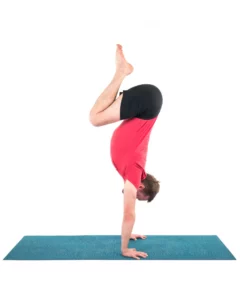Meet your I-Maker and Feel Less Alone

Article At A Glance
In January, after several months of not taking a weekly yoga class, I started again, in a different space, with a different teacher. One of the great benefits of taking a break and changing routines is that everything looks fresh, and emotions you’d forgotten come back to the surface, ripe for examination. Somewhat to my horror, the first thing that rippled the waters was that old sea snake, competition, aka the “I-maker.” I watched myself wanting to know how other people in the room were doing with the poses, silently clucking at someone else’s misalignment, and hearing the familiar urgent questions: Better than me? Worse than me? With them came a feeling of isolation, seeping in at the bottom of my consciousness and starting to rise.
In the past, I would give myself a quick mental wake-up slap. I’d say: “don’t compare,” and switch my attention back to the pose. This strategy works for as long it takes my mind to forget the instruction—somewhere between 30 seconds and five minutes. That day, I stumbled on something much more effective. I suddenly realized that I had just caught the I-maker (in Sanskrit Ahamkara) at work. And in the moment of thinking, “Ahamkara!” the tightness dissolved and something expansive gradually replaced it. I became keenly aware of the truth of the room—one life, fragmented into separate bodies. The sea snake was gone, without leaving a wake.
What is the I-Maker?

I sent a bouquet of gratitude to Birjoo Mehta, the extraordinary Iyengar teacher from Mumbai, whose explanation of the yogic idea of the mind is the clearest I’ve ever encountered. Yoga philosphy, Birjoo told us in a Vancouver workshop, divides the mind into three parts. Manas, the sensory input device, takes information from the senses and delivers it to buddhi, intelligence. Intelligence decides what to do with the sensory input, what meaning it has. Ahamkara, usually translated as ego, spends its time saying “me” or “not me” to whatever the mind encounters.
Countless decisions on the part of the I-maker accumulate to create the sense of a coherent self, enduring over time: I like birds. I like walking. I don’t like fusion jazz.
Ego is a charged word, often negative. But there is nothing wrong with the I-maker. It’s a necessary part of our minds. We couldn’t function without it.

But if we don’t know how it works, or that it even exists, the I-maker can go into overdrive. When it does, the result is alienation. We might feel inferior, or superior, but the result is always the same: suffering and an increase in ignorance (Avidya). In his supremely lucid translation of The Yoga Sutra of Patanjali, Chip Hartranft calls it “not seeing things as they are.”
How to Practice Letting Go
Just being aware of the I-maker can be enough to rein it back to healthy levels, especially given that yoga philosophy teaches that all of us, body, mind, emotions, along with all other beings and the inanimate world, are made of the same substance, Prakriti.
Here are some tips for practicing with your I-maker:
- Practice noting when the I-maker is at work, and you will find yourself less prey to an uncomfortable sense of isolation, no matter where you are or what you’re doing.
- Being aware of the I-maker is invaluable in class to turn your awareness back to your own work. It is just as useful in awkward social situations, where it allows you to relax and feel connection instead of separation.
- Resist the tendency to scold. Just note the I-maker at work. Whenever you catch yourself being caught up in Ahamkara, try yoga teacher Judith Hanson Lasater’s suggestion and say: “how very human of me.”
Also, read...
Restorative Yoga: A Sequence to Build and Maintain Resilience
Pranayama: Expand Your Life Energy
Nyasas: Turn Your Body into a Temple
Related courses

Eve Johnson taught Iyengar Yoga for 18 years before being introduced to Spinefulness in 2016. Convinced by the logic, clarity, and effectiveness of Spinefulness alignment, she took the teacher training course and was certified in July 2018. Eve teaches Spineful Yoga over Zoom and offers an online Spinefulness Foundations course. For course information, go to http://spinefulness.ca.



